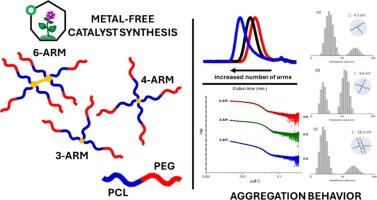Metal-free ring-opening polymerization for the synthesis of biocompatible star-shaped block copolymers with controllable architecture
IF 5.8
2区 化学
Q1 POLYMER SCIENCE
引用次数: 0
Abstract
Star-shaped block copolymers (SBCs) have sparked interest as efficient cargo carriers due to their high loading capacity, decreased burst effects through sustained release, and maintained stability in dilute aqueous solution. Despite these advantages, the practical usage of SBCs is hindered by their challenging synthesis processes that often utilize metal-based catalysts at high temperatures. Herein we report the tailored synthesis of 3-, 4-, and 6-arm polycaprolactone-b-poly(ethylene glycol), PCL-b-PEG, SBCs using diphenyl phosphate as a friendlier, more sustainable non-metallic catalyst. Nuclear magnetic resonance (NMR) analysis confirms the molecular architecture of SBCs and gel permeation chromatography (GPC) is used to elucidate trends in molar mass when the number of arms within the SBCs is tuned, while dynamic light scattering (DLS) and small-angle X-ray scattering (SAXS) studies provide insights into aggregation behavior. Critical aggregation concentration (CAC) values, as measured by fluorescence spectroscopy, demonstrated that the 4-arm and 6-arm SBCs have greater stability than the 3-arm SBC. Biocompatibility assessment indicated minimal cytotoxicity of the nanoaggregates, even at high concentration, making these PCL-b-PEG SBCs potentially safe and sustainable vehicles for biomedical release applications.

无金属开环聚合法合成结构可控的生物相容性星形嵌段共聚物
星形嵌段共聚物(SBC)具有装载量高、通过持续释放减少爆裂效应以及在稀释水溶液中保持稳定等优点,因此作为高效货物载体引发了人们的兴趣。尽管具有这些优点,但 SBC 的实际应用却受到其具有挑战性的合成工艺的阻碍,这些工艺通常需要在高温下使用金属催化剂。在此,我们报告了使用磷酸二苯酯作为更友好、更可持续的非金属催化剂,定制合成 3、4 和 6 臂聚己内酯-b-聚乙二醇(PCL-b-PEG)SBC 的情况。核磁共振(NMR)分析证实了 SBC 的分子结构,凝胶渗透色谱法(GPC)用于阐明调整 SBC 中臂的数量时摩尔质量的变化趋势,而动态光散射(DLS)和小角 X 射线散射(SAXS)研究则为聚合行为提供了见解。通过荧光光谱测定的临界聚集浓度(CAC)值表明,4 臂和 6 臂 SBC 比 3 臂 SBC 具有更高的稳定性。生物相容性评估表明,即使在高浓度下,纳米聚集体的细胞毒性也很小,因此这些 PCL-b-PEG SBC 有可能成为生物医学释放应用中安全、可持续的载体。
本文章由计算机程序翻译,如有差异,请以英文原文为准。
求助全文
约1分钟内获得全文
求助全文
来源期刊

European Polymer Journal
化学-高分子科学
CiteScore
9.90
自引率
10.00%
发文量
691
审稿时长
23 days
期刊介绍:
European Polymer Journal is dedicated to publishing work on fundamental and applied polymer chemistry and macromolecular materials. The journal covers all aspects of polymer synthesis, including polymerization mechanisms and chemical functional transformations, with a focus on novel polymers and the relationships between molecular structure and polymer properties. In addition, we welcome submissions on bio-based or renewable polymers, stimuli-responsive systems and polymer bio-hybrids. European Polymer Journal also publishes research on the biomedical application of polymers, including drug delivery and regenerative medicine. The main scope is covered but not limited to the following core research areas:
Polymer synthesis and functionalization
• Novel synthetic routes for polymerization, functional modification, controlled/living polymerization and precision polymers.
Stimuli-responsive polymers
• Including shape memory and self-healing polymers.
Supramolecular polymers and self-assembly
• Molecular recognition and higher order polymer structures.
Renewable and sustainable polymers
• Bio-based, biodegradable and anti-microbial polymers and polymeric bio-nanocomposites.
Polymers at interfaces and surfaces
• Chemistry and engineering of surfaces with biological relevance, including patterning, antifouling polymers and polymers for membrane applications.
Biomedical applications and nanomedicine
• Polymers for regenerative medicine, drug delivery molecular release and gene therapy
The scope of European Polymer Journal no longer includes Polymer Physics.
 求助内容:
求助内容: 应助结果提醒方式:
应助结果提醒方式:


